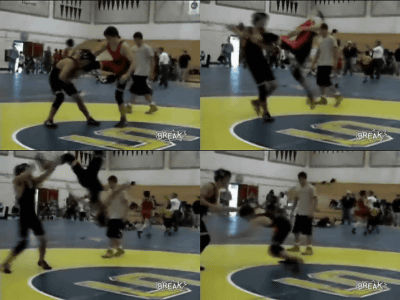'Finger patching' turned out to be the movement that produces the highest acceleration in the human body

Many people should have practiced and learned
The ultrafast snap of a finger is mediated by skin friction | Journal of The Royal Society Interface
https://royalsocietypublishing.org/doi/10.1098/rsif.2021.0672

`Oh, snap!'A record-breaking motion at our f | Eurek Alert!
https://www.eurekalert.org/news-releases/934621
Scientists find the fastest acceleration in the human body | Live Science
https://www.livescience.com/thanos-finger-finger-snap-fastest-acceleration-human-body
Why Thanos couldn't have snapped his fingers while wearing the Infinity Glove | Ars Technica
https://arstechnica.com/science/2021/11/why-thanos-couldnt-have-snapped-his-fingers-while-wearing-the-infinity-glove/
Finger snapping has existed as a human culture since ancient times and is also depicted in ancient Greek paintings around 300 BC. Also, in the 2018 movie ' Avengers: Infinity War ', Supervillain Thanos ' finger patching was a hot topic.
In previous research, research teams at Georgia Institute of Technology and Harvey Mad University in the United States have developed a general framework for explaining the surprisingly powerful and ultra-fast movements observed in living organisms. Under such circumstances, the research team who saw 'Avengers / Infinity War' was interested in applying this framework to 'finger patching'.
Thanos wears a metal Infinity Gauntlet in the movie, but this condition affects the friction of the skin, which is thought to be involved in finger patching, so he was an assistant professor of chemistry and biomolecular engineering at Georgia Institute of Technology. Saad Bhamla, who works, thought, 'Isn't Thanos wearing a gauntlet unable to snap fingers?' 'We went into a heated debate trying to figure out if Thanos could actually snap a finger,' Bhalma said.

Therefore, the research team considered that the friction between the thumb and middle finger plays an important role in the retention and release of energy in the finger patching, and conducted an experiment to analyze the movement of the finger patching under various conditions.
In the experiment, a high-speed camera was used to photograph finger patching performed by three different subjects from various angles. The subject put a marker tape on the wrist joint, the base of the finger, the finger joint, and the tip of the middle finger, and under various conditions such as bare hands, smooth rubber gloves, rubber thimble, and metal thimble under the rubber gloves. I did thimbles 5 times each. In addition, in order to prevent arm and finger fatigue from affecting the accuracy of finger patching, a one-minute break was provided between each finger patching to reduce muscle fatigue.
As a result of analyzing the recorded data using high-speed image processing, automatic image processing, dynamic force sensor, etc., finger patching with bare hands can have a rotation speed of 7800 degrees per second and a rotation acceleration of 1.6 million degrees 2 per second. Turned out. The rotation speed of the finger patchon is slower than the highest ever recorded 'rotation speed of the arm when a professional baseball pitcher throws', but the rotation acceleration is three times higher than this, which is this. The research team states that it has 'the highest rotational acceleration produced by the human body' that has been measured so far.
'For the past few years, we've been fascinated by how we snap our fingers. It's a really amazing physics puzzle that's at our fingertips but hasn't been scrutinized,' Bhamla said. When I first saw the data, I jumped out of my chair. The finger patching occurred in just 7ms, more than 20 times faster than a blink that took 150ms. '

In finger patchon, the arm muscle becomes a 'motor' and loads potential energy on the tendon of the finger, and the potential energy stored by stretching the thumb and middle finger is rubbed by the middle finger and thumb and in a short time. It is a mechanism to release. However, it was found that wearing rubber gloves, thimbles, metal thimbles, etc. would increase friction and lose the skin-specific compressibility required for snapping, making finger patching impossible. ..
The results of this experiment, in which human skin constitutes the 'optimal friction zone for finger patching,' were also confirmed by a mathematical model. The new finger patchon model will be key to understanding other biomechanical movements such as how ants and termites store force in the jaw, and may help improve frictional dynamics such as high-tech prosthesis design and soft robotics. There is.
'Our findings suggest that Thanos couldn't snap fingers because he covered his fingers with metal armor,' said Raghav Acharya, an undergraduate student at Georgia Institute of Technology, the lead author of the paper. In other words, it's probably Hollywood's special effects, not the actual physics! '

by Michael Li
Related Posts:







